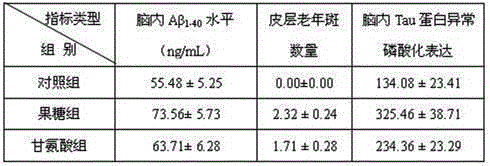Application of glycine to preparation of medicine for treating AD (alzheimer diseases)
A technology for Alzheimer's disease and glycine, applied in the field of glycine, can solve problems such as lack of effective drugs for treatment, achieve significant prevention and treatment effects, and improve memory function.
- Summary
- Abstract
- Description
- Claims
- Application Information
AI Technical Summary
Problems solved by technology
Method used
Image
Examples
Embodiment 1
[0008] Example 1: Effect of glycine on AD rats induced by high fructose.
[0009] Experimental method: 24 rats were randomly divided into control group, high fructose group and glycine group, with 8 rats in each group. The control group was fed with tap water; the high fructose group was fed with 8% fructose water; the glycine group was fed with 8% fructose water and 1% glycine at the same time, and the rats in the above groups were free to eat (standard large rat feed). After 8 months of administration, the Morris water maze experiment was carried out to each group of rats. The Morris water maze was a study designed and applied to the brain learning and memory mechanism by the British psychologist Morris in the 1980s (1981). It is commonly used in research to test the memory function of animals. The Morris water maze test mainly consists of a place navigation test. This test lasted for 5 days. Rats were put into the water from 4 water entry points facing the pool wall sever...
Embodiment 2
[0017] Embodiment 2: Glycine to galactose+AlCl 3 Effects of Induced AD Rats.
[0018] Experimental method: 30 rats were randomly divided into control group, galactose group and glycine group, with 10 rats in each group. The control group ate normally, and the galactose group was intraperitoneally injected with D-galactose (60 mg·kg -1 d -1 )+AlCl 3 (25mg·kg -1 d -1 ), the glycine group received intraperitoneal injection of D-galactose (60 mg·kg -1 d -1 )+AlCl 3 (25mg·kg -1 d -1 ) at the same time oral glycine (5 mg·g -1 d -1 ), the above rats were free to eat (tap water and standard rat chow). After 3 months, the Morris water maze test and other related AD indicators were tested on the rats in each group.
[0019] Experimental results: as shown in Table 3 below, compared with the control group, the memory function of the rats in the galactose group was severely impaired ( P P 0.05); indicating that glycine can improve memory function.
[0020] Table 3 The re...
PUM
 Login to View More
Login to View More Abstract
Description
Claims
Application Information
 Login to View More
Login to View More - R&D
- Intellectual Property
- Life Sciences
- Materials
- Tech Scout
- Unparalleled Data Quality
- Higher Quality Content
- 60% Fewer Hallucinations
Browse by: Latest US Patents, China's latest patents, Technical Efficacy Thesaurus, Application Domain, Technology Topic, Popular Technical Reports.
© 2025 PatSnap. All rights reserved.Legal|Privacy policy|Modern Slavery Act Transparency Statement|Sitemap|About US| Contact US: help@patsnap.com



